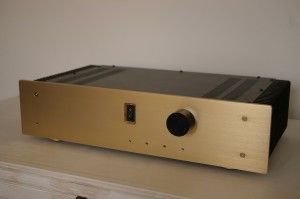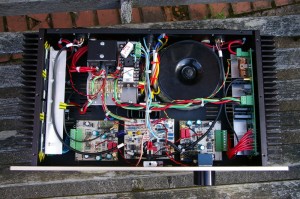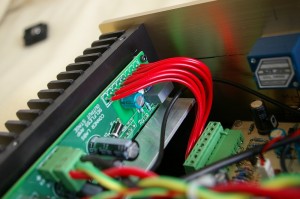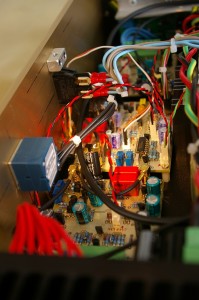This is another very long-running project that I’ve just completed recently. (It’s my first big one of the Web 2.0 era, so you can read my blog posts about it.)
The story began immediately after I built my Alexander current-feedback amp, the “Ice Block“. I got a copy of Douglas Self’s “Audio Power Amplifier Design Handbook”, which I’d somehow managed to avoid reading up until then. Self persuaded me that I’d fallen for the MOSFET propaganda and not given BJTs a fair trial, and I decided I must build one of his “Blameless” amps.
Several years passed, and several half-hearted attempts at it failed to get off the ground. I couldn’t decide whether it should be a hi-fi amp, a bass amp, or how big it should be. Once I bought a 1kVA transformer, and built an enormous output stage with eight TO3 devices mounted on an old thyristor heatsink. It languished and I eventually took it apart without ever applying power.
Two moves of house and two job changes later, I decided to quit polyprojecting around and get it done. I made up my mind that it should be a modestly-sized hi-fi amp of around 100-120W into 4 ohms. And, in the 10 years I spent dithering, ON Semi had brought out their new “ThermalTrak” power transistors with integrated temperature sensing diodes, so I decided to use those in my output stages.
Changing from TO-3 to TO-247 transistors meant that none of my junk box heatsinks would fit. As I had more money and less patience than 10 years ago, I bought a ready-made power amp chassis from Tang Hill of Taiwan. This cost about £180 by the time VAT and shipping were factored in. It was labelled as an “Art & Power P-100” or similar, and was probably surplus from a batch they made for some other customer. In any case, a quick rub with petrol and WD-40 removed the screenprinted lettering from the front panel.
Along similar lines, instead of messing about with stripboard and the like, I designed and ordered a set of PCBs. The output stage ones are 4 layer, because I felt this would be a really neat way of minimizing loop area, and so radiation of halfwave currents, which is one of Self’s “Eight Distortions”. I laid them out as if I was making some high-frequency inverter for a Tesla coil. The 4 layer boards were expensive, but still cheaper than, say, a cryo treated power cord. 🙂
On the subject of tweaks, I made some choices that audiophiles might find, well, interesting. Several internal connections are made with the green Phoenix Contact plugs, rather than being, say, lovingly soldered with silver-bearing solder. This means that the amp comes apart easily for service, troubleshooting and tweaking. In a slight concession to audiophilia, though, I used RG213 coax and gold-plated SMB connectors for the unbalanced input and feedback paths. Not to mention some nice looking speaker binding posts, salvaged from a pair of Tannoy speakers I found by the kerb with blown drivers.
The finished amp has dual-slope SOA, overtemperature and DC offset protection, anti-thump, soft-start, balanced inputs, and most importantly, a big shiny £16 volume knob obtained from Hi-Fi Collective.
The only annoying thing about it is the power transformer, a 500VA toroidal unit obtained from Farnell. It hums a bit acoustically, and leaks flux into the right channel power amp board, causing it to buzz. This is only just audible by sticking your ear up against the right speaker, and certainly doesn’t interfere with my listening enjoyment. But it would utterly wreck a THD measurement made to Douglas Self’s standards. So the solution is to use the left channel for THD measurements. 🙂
And what, you might ask, does it sound like? As far as I can tell, it doesn’t sound like anything. However, it does make my Crown SXA sound like a crusty old heap of junk. For the time being it’s retired.
(PS: it also trashed the Ice Block in a listening test and that is now retired too. I think it must have something wrong with it.)




